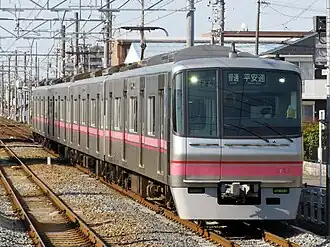Meitetsu 300 series
| Meitetsu 300 series | |
|---|---|
 301 in April 2021 | |
| In service | 2002–present |
| Manufacturer | Nippon Sharyo |
| Constructed | 2002 |
| Entered service | 1 April 2002 |
| Number built | 32 vehicles (8 sets) |
| Number in service | 32 vehicles (8 sets) |
| Formation | 4 cars per trainset |
| Fleet numbers | 301 - 308 |
| Capacity | 530 |
| Operators | |
| Lines served | |
| Specifications | |
| Car body construction | Stainless steel |
| Car length |
|
| Width | 2,746 mm (9 ft 0.1 in) |
| Height | 3.62 m (11 ft 11 in) |
| Doors | 4 pairs per side |
| Maximum speed | 100 km/h (62 mph) |
| Traction system | 2-level IGBT–VVVF |
| Traction motors | 4 × 170 kW (228 hp) 3-phase AC induction motor |
| Power output | 1.36 MW (1,824 hp) |
| Acceleration | 3.0 km/(h⋅s) (1.9 mph/s) |
| Deceleration |
|
| Electric system(s) | 1,500 V DC (overhead catenary) |
| Current collection | Pantograph |
| Bogies | bolsterless |
| Safety system(s) |
|
| Track gauge | 1,067 mm (3 ft 6 in) |
The Meitetsu 300 series (名鉄300系) is a commuter electric multiple unit operated by Nagoya Railroad (Meitetsu) on the Meitetsu Komaki Line and inter-running services through the Nagoya Subway Kamiiida Line in Japan since 2002.[1] They operate alongside the Nagoya Municipal Subway 7000 series introduced in 2003.
Design
The 300 series is Meitetsu's first train type to use stainless steel construction.[2] Its design served as a basis for the 3300 and 3150 series introduced in 2004.[3]
Internally, the trains are equipped with a mixture of longitudinal and transverse seating, with transverse seats at the ends of each car. Priority seating and wheelchair spaces are provided.[2]
Formation
The trainsets are formed as follows.[4][2]
| Inuyama →
| ||||
| Car No. | 1 | 2 | 3 | 4 |
| Designation | Ku 310 (Tc1) |
Mo 320 (M2) |
Mo 330 (M1) |
Ku 340 (Tc2) |
| Weight (t) | 30.4 | 37.0 | 34.6 | 30.4 |
| Capacity Total/seated |
130/39 | 135/46 | 135/46 | 130/39 |
The M1 and M2 cars are each fitted with one single-arm pantograph.[5]
History
The first cars were delivered in 2002, entering service from April 2002.[6]
References
- ^ 300系 [300 series]. Meitetsu Museum of Rolling Stock (in Japanese). Nagoya Railroad, Inc. Archived from the original on 11 December 2010. Retrieved 15 November 2010.
- ^ a b c 名古屋鉄道 300系 [Nagoya Railroad 300 series]. Japan Railfan Magazine (in Japanese). Vol. 42, no. 494. Japan: Koyusha Co., Ltd. June 2002. pp. 71–78.
- ^ 私鉄車両年鑑2013 [Japan Private Railways Annual 2013] (in Japanese). Tokyo, Japan: Ikaros Publications Ltd. 20 March 2013. p. 225. ISBN 978-4-86320-693-9.
- ^ 名古屋鉄道300系通勤電車 [Nagoya Railroad Commuter EMU]. Rolling Stock (in Japanese). Nippon Sharyo. Retrieved 16 November 2010.
- ^ 私鉄車両編成表 2010 [Private Railway Rolling Stock Formations - 2010]. Japan: JRR. August 2010. p. 89. ISBN 978-4-330-15310-0.
- ^ 名古屋鉄道殿向 300系納入 上飯田連絡線専用車両 [The Supply of the 300 Series to Nagoya Railroad, Trains for the Line Connecting to Kamiiida]. Rolling Stock Topics (in Japanese). Nippon Sharyo. Archived from the original on 6 August 2015. Retrieved 15 November 2010.
External links
 Media related to Meitetsu 300 series at Wikimedia Commons
Media related to Meitetsu 300 series at Wikimedia Commons- Meitetsu's description of the 300 series (in Japanese)
- Manufacturer's description of the 300 series (in Japanese)